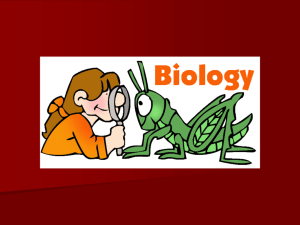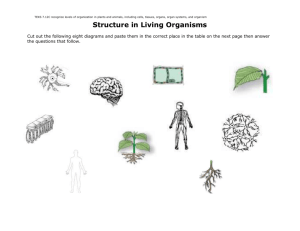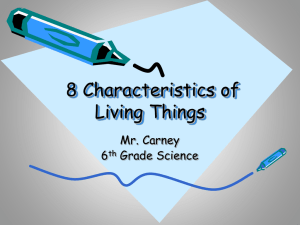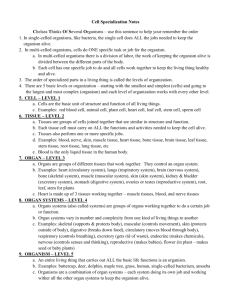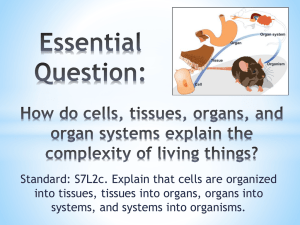General Biology Exam 1
advertisement
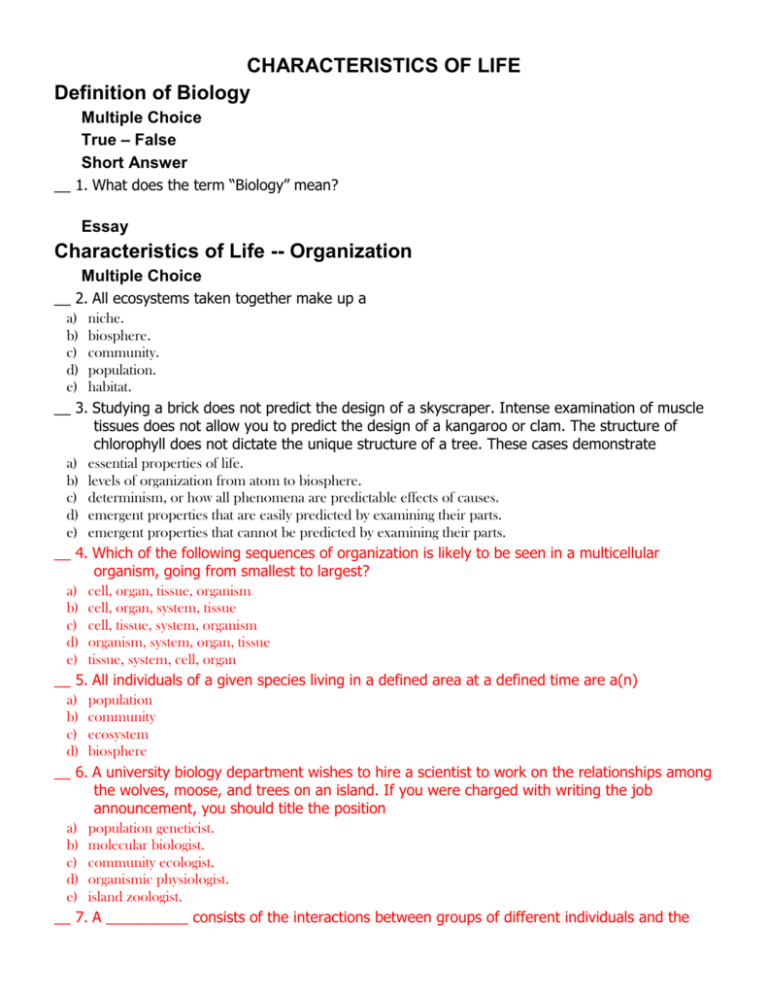
CHARACTERISTICS OF LIFE Definition of Biology Multiple Choice True – False Short Answer __ 1. What does the term “Biology” mean? Essay Characteristics of Life -- Organization Multiple Choice __ 2. All ecosystems taken together make up a a) niche. b) biosphere. c) community. d) population. e) habitat. __ 3. Studying a brick does not predict the design of a skyscraper. Intense examination of muscle tissues does not allow you to predict the design of a kangaroo or clam. The structure of chlorophyll does not dictate the unique structure of a tree. These cases demonstrate a) essential properties of life. b) levels of organization from atom to biosphere. c) determinism, or how all phenomena are predictable effects of causes. d) emergent properties that are easily predicted by examining their parts. e) emergent properties that cannot be predicted by examining their parts. __ 4. Which of the following sequences of organization is likely to be seen in a multicellular organism, going from smallest to largest? a) cell, organ, tissue, organism b) cell, organ, system, tissue c) cell, tissue, system, organism d) organism, system, organ, tissue e) tissue, system, cell, organ __ 5. All individuals of a given species living in a defined area at a defined time are a(n) a) population b) community c) ecosystem d) biosphere __ 6. A university biology department wishes to hire a scientist to work on the relationships among the wolves, moose, and trees on an island. If you were charged with writing the job announcement, you should title the position a) population geneticist. b) molecular biologist. c) community ecologist. d) organismic physiologist. e) island zoologist. __ 7. A __________ consists of the interactions between groups of different individuals and the non-living factors in a particular area. a) population b) ecosystem c) community d) domain e) biosphere __ 8. All members of one species form a: a) biosphere b) ecosystem c) population d) community e) country __ 9. Which of the following does not comprise a logical hierarchy of organization? a) molecules, atoms, organelles, tissues, systems b) atoms, molecules, cells, tissues, organ systems c) cells, tissues, organs, organ systems, organisms d) organisms, populations, communities, biomes, biosphere e) family, order, class, phylum, kingdom __ 10. All populations in one natural setting plus their physical environment constitutes a(n): a) biosphere b) ecosystem c) population d) community e) country __ 11. Which of the following represents the lowest level of organization in the group? a) Biosphere b) Community c) Population d) Species e) Ecosystem __ 12. Which correctly indicates the sequence of increasing organization? a) molecule, cell, organelle, organ b) organelle, tissue, cell, organ c) atom, molecule, organelle, cell d) organ, tissue, cell, molecule e) cell, organ, tissue, organ system __ 13. Which of the following levels in the hierarchy of biological organization include all of the other levels in the list? a) organ system b) organism c) population d) ecosystem e) community __ 14. Which of the following levels in the hierarchy of biological organization includes all of the other levels in the list? a) organelles b) macro molecules c) cells d) atoms e) tissues __ 15. With each step upward in the hierarchy of biological order, novel properties emerge that were not present at the simpler levels of organization. These emergent properties result from a) vital forces that arise at each level. b) the physical and chemical phenomena that operate only in living things. c) the arrangement and interactions between components. d) simple summation of the individual behavior of the component parts. e) the emergence of supernatural forces. __ 16. Organs are composed of tissues, which are composed of cells. This is an example of which characteristic of life? a) Living things grow and develop b) Living things respond to stimuli c) Living things maintain themselves by homeostasis d) Living things have levels of organization e) Living things are adapted to their environment __ 17. The study of tissues is called: a) cytology b) molecular biology c) histology d) parasitology e) pathology __ 18. Which of the following is composed of two or more tissue types that come together to perform a function? a) organs b) organ systems c) organisms d) cells e) macromolecules __ 19. A physician specializes on surgery involving the esophagus, stomach, and intestines. This physician is specialized at which level of organization. a) cell b) tissue c) organ d) organ system e) organism __ 20. Which sequence correctly lists the different levels of biological organization? a) cells - organs - tissues - organ systems - organism b) cells - tissues - organ systems - organs - organism c) tissues - cells - organs - organ systems - organism d) tissues - organs - organ systems - organism - cells e) cells - tissues - organs - organ systems - organism __ 21. Which of the following is the correct order of levels of organization from small to large? a) cell - organ - tissue - organ system - population - community - ecosystem b) cell - tissue - organ system - organ - population - community - ecosystem c) cell - tissue - organ - organ system - community - population - ecosystem d) cell - tissue - organ - organ system - population - community - ecosystem e) cell - tissue - organ system - organ - community - population - ecosystem True – False __ 22. The levels of organization of matter on Earth goes from smallest which are the subatomic particles to the largest which is the Biosphere. a) True b) False __ 23. Cytology is a branch of biology that studies cells. a) True b) False Short Answer __ 24. The smallest unit of life is the __________. __ 25. A large group of similar, interbreeding organisms is defined as a __________. __ 26. A group of very similar, interbreeding organisms belong to the same __________. __ 27. What are the levels of biological organization, starting from the smallest and proceeding in order to the largest? __ 28. Describe an ecosystem, and explain energy flow through an ecosystem. Essay Characteristics of Life -- Work Multiple Choice True – False Short Answer Essay Characteristics of Life – Energy & Matter Multiple Choice __ 29. An organism that uses CO2 for its source of carbon is referred to as a(n): a) heterotroph b) phototroph c) organotroph d) autotroph e) chemotroph __ 30. An organism that uses organic materials for its source of carbon is referred to as a(n): a) heterotroph b) phototroph c) organotroph d) autotroph e) chemotroph __ 31. An organism that uses light is referred to as a(n): a) heterotroph b) phototroph c) organotroph d) autotroph e) chemotroph __ 32. An organism that uses chemical is referred to as a(n): a) heterotroph b) phototroph c) organotroph d) autotroph e) chemotroph __ 33. What is the process by which the sun's energy is trapped as the source of energy used by virtually all living organisms? a) evolution b) metabolism c) adaptation d) homeostasis e) photosynthesis __ 34. Which of the following organisms is not ultimately dependent on the sun as a source of energy? a) A night-blooming flower is pollinated by night-flying bats. b) An underground earthworm avoids the sun. c) A cave fish feeds on debris that washes down to it. d) All of the choices ARE ultimately dependent on the sun. e) All of the choices are NOT ultimately dependent on the sun. __ 35. What is the name of all the chemical energy transformations that occur within a cell? a) evolution b) metabolism c) adaptation d) homeostasis e) photosynthesis __ 36. Metabolism is the sum of chemical reactions that occur in living cells, and we are accustomed to living cells continuously using energy and respiring. Even when plants and seeds are "dormant," we expect that they are carrying on metabolism but at a very slow rate. "Cryptobiosis" is a state of almost total loss of water seen in some roundworms, rotifers, and tardigrades and has been considered a near cessation of metabolism. Recently, a botanist working in a British museum accidentally spilled fluid on 120+ year old herbarium mounts. Fearing damage to the plant specimen, he immediately inspected it under the microscope only to find small tardigrades "waking up." Such observations a) support the claim that the tardigrades were always alive but respiring at a very slow rate. b) generate the possibility that we can bring most dead animals back to life. c) contradict the cell theory that all life comes from life. d) indicate that metabolism probably did totally stop, and that organization may be sufficient to maintain the possibility for "life." e) suggest that a "vital force" may be involved in defining when life is present. __ 37. What is metabolism? a) The consumption of energy. b) The release of energy. c) The sum of all chemical reactions taking place in an organism. d) The production of heat by chemical reactions. e) The exchange of nutrients and waste products with the environment. __ 38. The sum total of the chemical activity at the cellular level which enables an organism to meet its nutrient and energy demands is termed: a) Evolution b) Responsiveness c) Metabolism d) Growth e) Energy __ 39. Why do animals require "food" for survival? a) Food is a source of energy. b) Necessary chemicals are provided by food. c) Food is a primary source of water for all animals. d) a and b. e) a, b, and c. True – False __ 40. Photosynthetic bacteria are examples of autotrophs. a) True b) False __ 41. The only thing life forms require from their environment is energy. a) True b) False Short Answer Essay Characteristics of Life -- Homeostasis Multiple Choice __ 42. Humans sweat when the temperature gets hot so that they can cool themselves. This is an example of which characteristic of life? a) Growth b) Reproduction c) Homeostasis d) Evolve e) Response to stimuli __ 43. Homeostatic control in living things is exerted over all of the following EXCEPT a) temperature b) moisture level c) response to stimuli d) acidity level __ 44. What do we call the maintenance of internal conditions of an organism within a certain boundary range? a) evolution b) metabolism c) adaptation d) homeostasis e) photosynthesis __ 45. About twelve to twenty four hours after the lost meal, a person’s blood sugar level normally varies from about 60 to 90 milligrams per 100 milliliters of blood, though it may attain 130 mg / 100 ml after meals high in carbohydrates. That the blood sugar level is maintained within a fairly narrow range in spite of uneven intake of sugar is due to the body’s ability to carry out a) adaptation b) inheritance c) metabolism d) homeostasis e) all of the above __ 46. Which of the following terms is based on the Greek root words for "holding still" or "to be standing"? a) evolution b) metabolism c) adaptation d) homeostasis e) photosynthesis __ 47. Which of the following does NOT represent homeostasis? a) Sensors detect CO2 levels in the blood and trigger an increase or decrease in the rate of breathing. b) When body temperature drops, you shiver to generate heat; when your body heats up, you sweat and the evaporation cools you. c) Feelings of hunger and then fullness affect the length of time and quantity of food you eat, keeping your weight near a "set point." d) Energy is captured by plants, then transferred to consumers and decomposers, and eventually lost as heat. e) Cells adjusting the openings on the bottom of leaves respond to differences in water stress in order to maintain moisture inside the leaf. __ 48. The ability to maintain a constant internal environment is a) metabolism b) homeostasis c) development d) physiology e) thermoregulation __ 49. Homeostasis a) prevents drastic changes in internal environmental conditions. b) duplicates the external environment inside the living organism. c) requires only the replacement for materials that are used up by cells. d) is controlled solely by positive feedback reactions e) none of the above __ 50. You drink a glass of lemonade, but your body's pH does not change. This is an example of how organisms: a) maintain homeostasis. b) maintain organization. c) adapt to their environment. d) are immune to acid. e) are what they eat. __ 51. Humans born without sweat glands usually do not survive. Why not? a) Sweating is an important mechanism for maintaining temperature homeostasis. b) Sweat glands create openings in the skin where gas exchange occurs. c) Sweating is an important way of ridding the body of excess water. d) Sweating is important for purging impurities from the body. e) Sweat builds up in the body which causes swelling and tissue damage. __ 52. An organism's ability to maintain internal stability when the external environment changes is termed: a) Mutation b) Natural selection c) Responsiveness d) Metabolism e) Homeostasis __ 53. Which term is based on Greek root words meaning "ordered arrangement of the home"? a) biology b) biosphere c) homeostasis d) photosynthesis e) ecosystem True – False Short Answer Essay Characteristics of Life – Respond to stimuli Multiple Choice __ 54. A sunflower follows the sun as it move across the sky during the day. This is an example of which characteristic of life? a) Growth b) Reproduction c) Homeostasis d) Evolve e) Response to stimuli __ 55. A paramecium will move from direct light. This is an example of which characteristic of life? a) Growth b) Reproduction c) Homeostasis d) Evolve e) Response to stimuli __ 56. Using his antennae, the male moth finds female moths by following a trail of airborne chemicals, called pheromones, upwind to the female producing them. This is an example of how living things... a) acquire nutrients b) grow c) reproduce d) respond to stimuli e) maintain homeostasis True – False Short Answer __ 57. Organisms respond to both internal and external stimuli. Describe the difference between these two types of stimuli and give an example of each. Essay Characteristics of Life – Reproduces Multiple Choice __ 58. A bacterium divides into two bacteria which are identical to, but smaller than, the original bacterium. This is an example of which characteristic of life? a) Growth b) Reproduction c) Homeostasis d) Evolve e) Response to stimuli __ 59. Which type of reproduction generates exact clones of each other? a) Sexual b) Meiosis c) Asexual d) all of these e) none of these True – False Short Answer Essay Characteristics of Life – Develop & Grow Multiple Choice __ 60. A puppy is born weighing 5 lbs and grows to be a 75 lb golden retriever. This is an example of which characteristic of life? a) Growth b) Reproduction c) Homeostasis d) Evolve e) Response to stimuli __ 61. At the beginning of the week a plant is 3 inches tall, and at the end of the week it is 4 inches. This is an example of which characteristic of life? a) Growth b) Reproduction c) Homeostasis d) Evolve e) Response to stimuli True – False Short Answer Essay Characteristics of Life – Evolves Multiple Choice __ 62. Over time the neck length of the giraffe has increased as only those giraffes with longer necks survived by eating the leaves high up on the trees and were able to reproduce and pass those long neck genes on to the next generation. This is an example of which characteristic of life? a) Growth b) Reproduction c) Homeostasis d) Evolve e) Response to stimuli __ 63. Which of the following is/are important to the theory of evolution? a) environmental change b) variation in traits within a population c) mutation d) inheritance of traits e) all of these __ 64. Which is NOT an example of evolution? a) Development of antibiotic-resistant bacteria. b) Flightless birds on islands without predators. c) This year's flu is different from last year's flu. d) A dog learns how to open the cabinet where its food is kept. e) Most commercial pesticides are effective for 2-3 years. __ 65. Some members of a species have a genetic change that causes them to be better suited to their environment. These members survive to reproduce and pass these genetic changes to their offspring. This is a) adaptation b) natural selection c) the driving force for evolution d) All of the choices are correct. e) None of the choices are correct. __ 66. Which of these is the process by which changes occur in the characteristics of species of organisms over time? a) evolution b) metabolism c) adaptation d) homeostasis e) photosynthesis __ 67. The changes in the human race since the time of the first humans is an example of: a) homeostasis b) hydrolysis c) evolution d) metabolism e) responsiveness __ 68. Evolution is "the biological theme that ties together all the others." This is because the process of evolution a) explains how organisms become adapted to their environment. b) explains the diversity of organisms. c) explains why all organisms have characteristics in common. d) explains why distantly-related organisms sometimes resemble one another. e) All of these are appropriate answers. __ 69. The bones in a bird are hollow so as to reduce its weight for flight. This is an example of which characteristic of life? a) Living things grow and develop b) Living things utilize materials and energy from the environment c) Living things reproduce d) Living things are adapted e) Living things are homeostatic __ 70. Mutation is essential to... a) an organism's survival. b) evolution. c) sexual reproduction. d) growth. e) gamete formation. __ 71. The concept of evolution is based upon a) genetic variation within a population. b) inheritance of variations by offspring of parents with the variations. c) survival and reproductive success of organisms with favorable variations. d) all genetic variation in a population is equally successful. e) all of the above. __ 72. All of the following are examples of adaptations, except a) mice learning a maze to get food. b) larger teeth in beavers for gnawing wood. c) different beak shape for birds that eat seeds vs. insects. d) insects that resemble twigs. e) flower coloration that attracts pollinators. __ 73. A mutation is a) a physical deformity b) a change in DNA sequence c) a dose of radiation d) a defective egg or sperm cell e) the inability to speak __ 74. In a word, evolution means ______. a) selection b) improvement c) mutation d) change e) nature __ 75. In evolutionary terms, which cell listed is considered to be most primitive? a) Protistan b) Prokaryotic c) Autotrophic d) Yeast e) Eukaryotic __ 76. Which of these is a peculiarity of form, function, or behavior that promotes the likelihood of a species' continued existence? a) evolution b) metabolism c) adaptation d) homeostasis e) photosynthesis __ 77. Evolution is described as change from pre-existing life forms to modern-day organisms. What actually changed? a) Rate of reproduction b) Ability of organisms to cope with external stimuli c) Energy and nutrition demands of the organisms d) Genetic makeup of the species e) The species' physical appearance __ 78. The characteristic of an individual that is necessary to the survival of the species but NOT to the survival of that individual is a) adaptation b) reproduction c) metabolism d) organization True – False __ 79. Variation among organisms is due to adaptations. a) True b) False __ 80. Adaptations aid in the survival and reproduction of an organism in a particular environment. a) True b) False __ 81. Extinction can occur if a species is unable to adapt to a changing environment. a) True b) False __ 82. Evolution is considered to be a unifying principle of biology since it explains both the unity and diversity of life. a) True b) False Short Answer __ 83. In terms of natural selection what does the phrase "survival of the fittest" mean? __ 84. Evolution is based on adaptations that aid in survival and reproduction of a species. List three different adaptations. __ 85. Errors or changes in the DNA molecule "blueprint" are called __________. __ 86. Which of the characteristics of life is not necessary for the survival of the individual, and why? __ 87. Explain how evolution is one of the great unifying theories of biology, accounting for both the unity and diversity of life. __ 88. Why is the species rather than the individual considered to evolve? Essay Characteristics of Life – General Multiple Choice __ 89. Which of the following is/are characteristic of living organisms? a) Organized structure b) Responsiveness to stimuli c) Maintenance of homeostasis d) b and c are correct e) a, b, and c are correct __ 90. Which of the following is true of ALL organisms? a) They are made of many cells linked together. b) They are highly organized. c) They reproduce sexually. d) They obtain nutrients. e) All of these are true. __ 91. Which of these is an organism? a) oak tree b) beetle c) dog d) bacterium e) all of these __ 92. The following statements are true about all living things EXCEPT a) They are made of cells or cell products. b) They are the products of evolution. c) They are composed of carbon, hydrogen, oxygen, and nitrogen. d) They undergo growth and development. e) They have a cell wall as an outer boundary. __ 93. Which of the following are properties of ALL life forms? 1. heritable programs in the form of DNA 2. photosynthesis 3. growth and development a) 1 b) 2 c) 3 d) Only 1 and 3 are correct. e) 1, 2, and 3 are correct. __ 94. A fossil was once a living organism but its tissues have been replaced by minerals and it no longer exhibits most properties of life, except for: a) organization b) homeostasis c) growth and reproduction d) response to stimuli e) metabolism __ 95. Clay particles in clay soil contain layered aluminum and iron compounds that determine the pattern of adjacent layers. This technically is a "self-replication", which is also a characteristic of life. a) Therefore clay is living. b) Clay is not living because it cannot think. c) Clay is not living because there is no chemical changes involved in soils. d) Clay is not living because it does not contain carbon; if it did, then it would be a living system. e) Clay is not living because this formation is a simple repetitive process without the ability to evolve or respond to the environment. __ 96. One classic definition of life is "a self-replicating molecular assemblage." However, clay particles (in clay soil) contain layered aluminum and iron compounds that determine the pattern of the adjacent layers of sediment. This is technically a self-replicating molecular assemblage. a) Therefore, it is living. b) It is not living because it cannot think. c) It is not living because there were no molecular changes (or chemistry) involved. d) It is not living because there is no carbon involved; otherwise, such duplication would be living. e) It is not living because it is a simple repetitive process without the ability to evolve or respond to the environment. __ 97. Which of the following is not characteristic of all life? a) responsiveness b) reproduction c) evolution d) random cell structure __ 98. A characteristic of life is: a) chemical bonds b) the production of CO2 c) the use of oxygen d) evolution __ 99. The reason plastics are not living is that: a) they do not contain carbon b) they are not responsive c) they cannot diffuse d) no one loves them __ 100. Living organisms are characterized by: a) adapting to the environment. b) evolving over time. c) displaying homeostatic mechanisms. d) all of the choices pertain to living organisms. __ 101. Organisms belonging to the same _____ would be the most closely related. a) kingdom b) phylum c) family d) class e) order __ 102. Which of the following is NOT one of the characteristics of living organisms? a) to be organized b) to respond c) to grow d) to metabolize e) All of the choices are characteristics of living organisms. __ 103. Which of the following characteristics is NOT required for the life of an individual organism to continue? a) to be organized b) to respond c) to metabolize d) to reproduce __ 104. Which statement is FALSE about nearly all living things? a) b) c) d) e) Living things are made up of cells. Living things must obey the laws of chemistry and physics. Living things show biological organization and other common characteristics of life. Emergent properties can be used to distinguish living things from nonliving things. Living things are composed only of organic elements, whereas nonliving things are made up of inorganic elements. __ 105. Concerning the nature of "life" (the property that makes living things differ from nonliving), which of the following statements would most biologists support? a) Development of an organism, even a single cell, is too complex to be explained by chemical and physical laws. b) The critical "vitalist" force that makes organisms live is of a different nature from nonliving chemistry and is yet to be discovered. c) Life consists of a property called "soul" and this leaves the body when an organism dies. d) Development of living forms from simple to complex forms contradicts physical laws. e) None of the statements is a mainline biology perspective. True – False __ 106. All living things contain a vital force that gives them the characteristics of life. a) True b) False Short Answer __ 107. List and briefly describe five characteristics of living organisms. Give an example of each. __ 108. Consider that quartz crystals have the ability to "grow" new crystal faces over time in the presence of solutions, "reproducing" new crystals off the parent pattern. Quartz also "responds" to light by generating a current. Since growth, reproduction and response are properties of life, why do we not consider quartz to be "alive"? __ 109. When the unmanned Viking spacecraft was sent to land on the surface of Mars, the foremost question was "Is there life on Mars?" Still photos and instrument readings had to be relayed back to earth as transmissions–no real material could be returned. Now, the discovery of possible fossil bacteria in a Mars meteorite has renewed our interest. What materials or properties would you search for with a Mars spacecraft lander to detect and/or confirm current life on Mars? Consider the following: water, carbon molecules, DNA, ATP, movement, and others. Essay __ 110. In 2020, you are the top biologist at a research station studying biodiversity in Costa Rica. A young scientist brings you a sample from a new, previously unexplored collection site. She asks you to look at the sample and determine if it is indeed a living organism. As you begin your investigations you must first decide what characteristics define life from non-life. How would you characterize a living organism to be able to differentiate it from something that is non-living? Consider some of the aspects of life that you learned in your biology courses as an undergraduate. __ 111. List four characteristics of living things and give an example to illustrate each. Characteristics of Life – Inheritance __ 112. A little boy is color-blind just as his grandfather was, even though his mother had normal vision. This situation is the result of a) adaptation b) inheritance c) metabolism d) homeostasis e) none of the above __ 113. The __________ molecule stores all the hereditary information of an organism.



